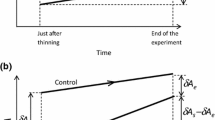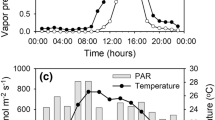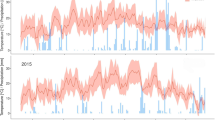Abstract
Canopy transpiration (E C) varies among forest stands with different structures. To evaluate different E C for Japanese cypress we observed E C for 5 months, by use of the sap flow technique, in two adjacent stands of different ages with contrasting structures. Mean diameter at breast height was 13.5 and 44.6 cm and stem density was 2100 and 350 trees ha−1 for the Sakuta and Hiwada plots, respectively. Mean E C measured was 1.3 mm day−1 for the Sakuta plot and 0.7 mm day−1 for the Hiwada plot (or 53 % of that for the Sakuta plot). This difference between E C was caused by differences between both mean stand sap flux density (J S) and stand sapwood area (A S__stand): J S for the Hiwada plot was 69 % of that for the Sakuta plot and A S_stand for the Hiwada plot was 75 % of that for the Sakuta plot. The difference between J S was primarily caused by different reference J S for given meteorological conditions, not by the different response of J S to meteorological conditions. Previous studies of coniferous plantation forests in Japan reported that differences between E C among stands with different structures were mainly caused by different A S_stand. This study revealed this is not always true, and that differences between J S should also be considered when predicting differences between E C among stands with different structures.









Similar content being viewed by others
References
Cienciala E, Kucera J, Lindroth A, Cermak J, Grelle A, Halldin S (1997) Canopy transpiration from boreal forest in Sweden during a dry summer. Agric For Meteorol 86:157–167
Clearwater MJ, Meinzer FC, Andrade JL, Goldstein G, Holbrook M (1999) Potential errors in measurements of nonuniform sap flow using heat dissipation probes. Tree Physiol 19:681–687
Ewers BE, Gower ST, Bond-Lamberty B, Wang CK (2005) Effects of stand age and tree species on canopy transpiration and average stomatal conductance of boreal forests. Plant Cell Environ 28:660–678
Ewers BE, Mackay DS, Tang J, Bolstad PV, Samanta S (2008) Intercomparison of sugar maple (Acer saccharum Marsh.) stand transpiration responses to environmental conditions from the Western Great Lakes Region of the United States. Agric For Meteorol 148:231–246
Ford CR, Hubbard RM, Kloeppel BD, Vose JM (2007) A comparison of sap flux-based evapotranspiration estimates with catchment-scale water balance. Agric For Meteorol 145:176–185
Ford CR, Hubbard RM, Vose JM (2010) Quantifying structural and physiological controls on variation in canopy transpiration among planted pine and hardwood species in the southern Appalachians. Ecohydrology. doi:10.1002/eco.136
Fujimori T (2006) Forest Ecology. Zenrinkyou, Tokyo (in Japanese)
Granier A (1987) Evaluation of transpiration in a Douglas-fir stand by means of sap flow measurements. Tree Physiol 3:309–320
Granier A, Biron P, Lemoine D (2000) Water balance, transpiration and canopy conductance in two beech stands. Agric For Meteorol 100:291–308
Hattori S, Tamai K, Abe T (1993) Effects of soil moisture and vapor pressure deficit on evapotranspiration in a hinoki plantation. J Jpn For Soc 75:216–224 (in Japanese with English summary)
Herbst M, Roberts JM, Rosier PTW, Taylor ME, Gowing DJ (2007) Edge effects and forest water use: a field study in mixed deciduous woodland. For Ecol Manag 250:176–186
Herbst M, Rosier PTW, Morecroft MD, Gowing DJ (2008) Comparative measurements of transpiration and canopy conductance in two mixed deciduous woodlands differing in structure and species composition. Tree Physiol 28:959–970
Imawaka S, Sato N (2008) Study on new forest maintenance projects by “Forest Environmental Tax”. Bull Kyushu Univ 89:75–126 (in Japanese with English summary)
Irvine J, Law BE, Anthoni PM, Meinzer FC (2002) Water limitations to carbon exchange in old-growth and young ponderosa pine stands. Tree Physiol 22:189–196
Irvine J, Law BE, Kurpius MR, Anthoni PM, Moore D, Schwarz PA (2004) Age-related changes in ecosystem structure and function and effects on water and carbon exchange in ponderosa pine. Tree Physiol 24:753–763
Japan Forestry Agency (2010) Current state of forest resources. http://www.rinya.maff.go.jp/j/keikaku/genkyou/h24/index.html (in Japanese). Accessed 8 June 2015
Jarvis PG, McNaughton KG (1986) Stomatal control of transpiration: scaling up from leaf to region. Adv Ecol Res 15:1–49
Komatsu H (2004) A general method of parameterizing the big-leaf model to predict the dry-canopy evaporation rate of individual coniferous forest stands. Hydrol Process 18:3019–3036
Komatsu H, Onozawa Y, Kume T, Tsuruta K, Shinohara Y, Otsuki K (2012) Canopy conductance for a Moso Bamboo (Phyllostachys pubescens) forest in western Japan. Agric For Meteorol 156:111–120
Kosugi Y, Katsuyama M (2007) Evapotranspiration over a Japanese cypress forest. II. Comparison of the eddy covariance and water budget methods. J Hydrol 334:305–311
Kumagai T, Aoki S, Nagasawa H, Mabuchi T, Kubota K, Inoue S, Utsumi Y, Otsuki K (2005a) Effects of tree-to-tree and radial variations on sap flow estimates of transpiration in Japanese cedar. Agric For Meteorol 135:110–116
Kumagai T, Nagasawa H, Mabuchi T, Ohsaki S, Kubota K, Kogi K, Utsumi Y, Koga S, Otsuki K (2005b) Sources of error in estimating stand transpiration using allometric relationships between stem diameter and sapwood area for Cryptmeria japonica and Chamaecyparis obtusa. For Ecol Manage 206:191–195
Kumagai T, Aoki S, Shimizu T, Otsuki K (2007) Sap flow estimates of stand transpiration at two slope positions in a Japanese cedar forest watershed. Tree Physiol 27:161–168
Kumagai T, Tateishi M, Shimizu T, Otsuki K (2008) Transpiration and canopy conductance at two slope positions in a Japanese cedar forest watershed. Agric For Meteorol 148:1444–1455
Kume T, Tsuruta K, Komatsu H, Kumagai T, Higashi N, Shinohara Y, Otsuki K (2010) Effects of sample size on sap flux-based stand-scale transpiration estimates. Tree Physiol 30:129–138
Kume T, Otuski K, Du S, Yamanaka N, Wang YL, Liu GB (2012) Spatial variation in sap flow velocity in semiarid region trees: its impact on stand-scale transpiration estimates. Hydrol Process 26:1161–1168
Kuraji K (2012) Blessings from forests are not existed?. Kagaku Dojin, Tokyo (in Japanese)
Lu P, Müller WJ, Chacko EK (2000) Spatial variations in xylem sap flux density in the trunk of orchard-grown, mature mango trees under changing soil water conditions. Tree Physiol 20:683–692
Macfarlane C, Bond C, White DA, Grigg AH, Ogden GN, Silberstein R (2010) Transpiration and hydraulic traits of old and regrowth eucalypt forest in southern Australia. Forest Ecol Manag 260:96–105
Matsumoto K, Ohta T, Nakai T, Kuwada T, Daikoku K, Iida S, Yabuki H, Kononov AV, van der Molen MK, Kodama Y, Maximov TC, Dolman AJ, Hattori S (2008) Responses of surface conductance to forest environments in the Far East. Agric For Meteorol 148:1926–1940
Monson R, Baldocchi D (2014) Terrestrial biosphere-atmosphere fluxes. Cambridge University Press, Cambridge
Moore GW, Bond BJ, Jones JA, Phillips N, Meinzer F (2004) Structural and compositional controls on transpiration in 40- and 450-year-old riparian forests in western Oregon, USA. Tree Physiol 24:481–491
Morikawa Y, Hattori S, Kiyono Y (1986) Transpiration of a 31-year-old Chamaecyparis obtusa Endl. stand before and after thinning. Tree Physiol 2:105–114
Oishi AC, Oren R, Stoy PC (2008) Estimating components of forest evapotranspiration: a footprint approach for scaling sap flux measurements. Agric For Meteorol 148:1719–1732
Oren R, Pataki DE (2001) Transpiration in response to variation in microclimate and soil moisture in southeastern deciduous forests. Oecologia 127:549–559
Oren R, Sperry JS, Katul GG, Pataki DE, Ewers BE, Phillips N, Schäfer KVR (1999) Survey and synthesis of intra- and interspecific variation in stomatal sensitivity to vapour pressure deficit. Plant Cell Environ 22:1515–1526
Oren R, Sperry JS, Ewers BE, Pataki DE, Phillips N, Megonigal JP (2001) Sensitivity of mean canopy stomatal conductance to vapor pressure deficit in a flooded Taxodium distichum L. forest: hydraulic and non-hydraulic effects. Oecologia 126:21–29
Pataki DE, Oren R (2003) Species differences in stomatal control of water loss at the canopy scale in a mature bottomland deciduous forest. Adv Water Res 26:1267–1278
Phillips N, Oren R (1998) A comparison of daily representations of canopy conductance based on two conditional time averaging methods and the dependence of daily conductance on environmental factors. Ann For Sci 55:217–235
Ryan MG, Yoder BJ (1997) Hydraulic limits to tree height and tree growth: what keeps trees from growing beyond a certain height? Bioscience 47:235–242
Schäfer KVR, Oren R, Tenhunen JD (2000) The effect of tree height on crown level stomatal conductance. Plant Cell Environ 23:365–375
Shinohara Y, Ide J, Kuramoto K, Komatsu H, Otsuki K (2009) A report on the hydrological observations in Ochozu experimental watershed. Bull Kyushu Univ 90:51–87 (in Japanese with English summary)
Shinohara Y, Tsuruta K, Ogura A, Noto F, Komatsu H, Otsuki K, Matuyama T (2013) Azimuthal and radial variations in sap flux density and effects on stand-scale transpiration estimates in a Japanese cedar forest. Tree Physiol 33:550–558
Tanaka K, Tanaka H, Nakamura A, Ohte N, Kobashi S (1996) Conductance at a community level and characteristics of CO2 exchange in a hinoki (Chamaecyparis obtusa) stand. J Jpn For Soc 78:266–272 (in Japanese with English summary)
Tateishi M, Kumagai T, Utsumi Y, Umebayashi T, Shiiba Y, Inoue K, Kaji K, Cho K, Otsuki K (2008) Spatial variations in xylem sap flux density in evergreen oak trees with radial-porous wood: comparisons with anatomical observations. Trees 22:23–30
Tsuruta K, Kume T, Komatsu H, Higashi N, Umebayashi T, Kumagai T, Otsuki K (2010) Azimuthal variations of sap flux density within Japanese cypress xylem trunks and their effects on tree transpiration estimates. J For Res 15:398–403
Tsuruta K, Komatsu H, Shinohara Y, Kume T, Ichihashi R, Otsuki K (2011) Allometric equations between stem diameter and sapwood area of Japanese cedar and Japanese cypress for stand transpiration estimates using sap flow measurement. J Jpn Soc Hydrol Water Resour 24:261–270
Vertessy RA, Watson FGR, O’Sullivan SK (2001) Factors determining relations between stand age and catchment water balance in mountain ash forests. For Ecol Manag 143:13–26
Wilson KB, Hason PJ, Mulholland PJ, Baldocchi DD, Wullschleger SD (2001) A comparison of methods for determining forest evapotranspiration and its components: sap-flow, soil water budget, eddy covariance and catchment water balance. Agric For Meteorol 106:153–168
Zimmermann R, Schulze E-D, Wirth C, Schulze E-E, McDonald KC, Vygodskaya NN, Ziegler W (2000) Canopy transpiration in a chronosequence of Central Siberian pine forests. Glob Chang Biol 6:25–37
Acknowledgments
The authors are grateful to members of the Laboratory of Ecohydrology (Kyushu University) and Dr Natsuko Yoshihuji (Kyoto University), for assistance with field measurements, and to three anonymous reviewers for providing critical comments. This work was supported by the Global COE Program (Center of Excellence for Asian Conservation Ecology as a Basis of Human-nature Mutualism), MEXT, Japan, the “Institutional Program for Young Researcher Overseas Visits” from the Japan Society for the Promotion of Science, the CREST (Core Research for Environmental Science and Technology) program of “Development of Innovative Technologies for Increasing in Watershed Runoff and Improving River Environment by the Management Practice of Devastated Forest Plantation”, and the Fund of Fukuoka Prefecture Forest for Water Resources.
Author information
Authors and Affiliations
Corresponding author
About this article
Cite this article
Tsuruta, K., Komatsu, H., Kume, T. et al. Canopy transpiration in two Japanese cypress forests with contrasting structures. J For Res 20, 464–474 (2015). https://doi.org/10.1007/s10310-015-0495-0
Received:
Accepted:
Published:
Issue Date:
DOI: https://doi.org/10.1007/s10310-015-0495-0




